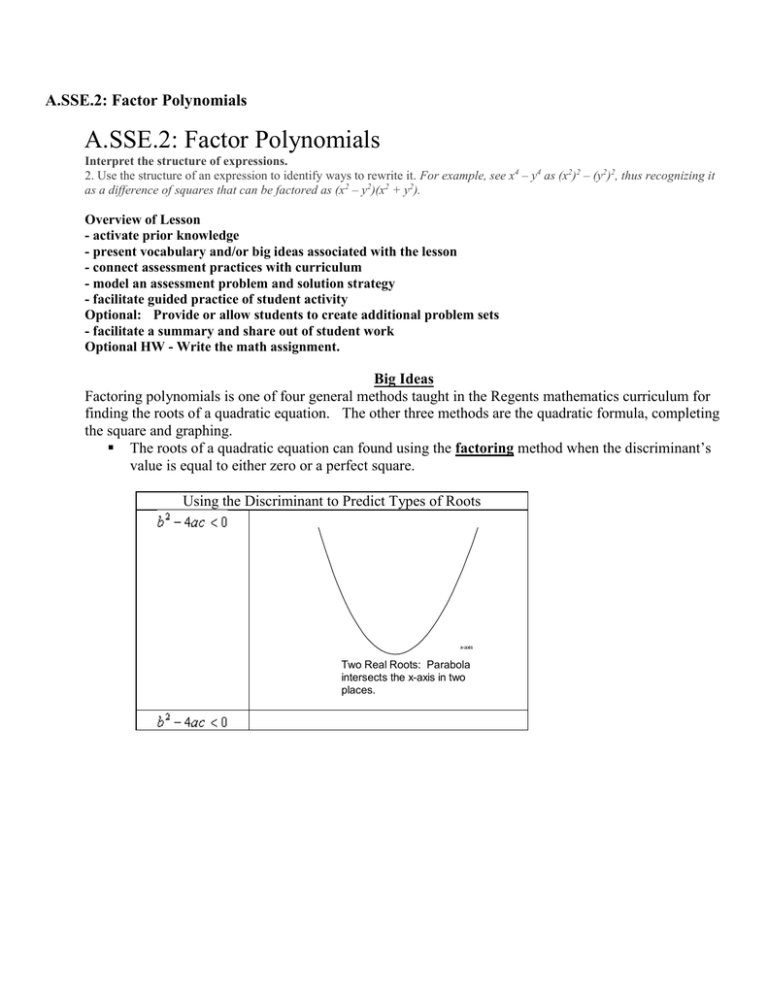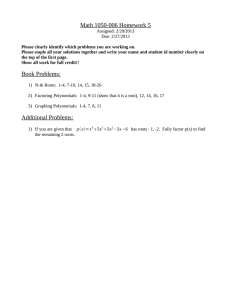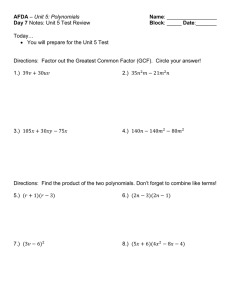A.SSE.2: Factor Polynomials
advertisement

A.SSE.2: Factor Polynomials A.SSE.2: Factor Polynomials Interpret the structure of expressions. 2. Use the structure of an expression to identify ways to rewrite it. For example, see x4 – y4 as (x2)2 – (y2)2, thus recognizing it as a difference of squares that can be factored as (x2 – y2)(x2 + y2). Overview of Lesson - activate prior knowledge - present vocabulary and/or big ideas associated with the lesson - connect assessment practices with curriculum - model an assessment problem and solution strategy - facilitate guided practice of student activity Optional: Provide or allow students to create additional problem sets - facilitate a summary and share out of student work Optional HW - Write the math assignment. Big Ideas Factoring polynomials is one of four general methods taught in the Regents mathematics curriculum for finding the roots of a quadratic equation. The other three methods are the quadratic formula, completing the square and graphing. The roots of a quadratic equation can found using the factoring method when the discriminant’s value is equal to either zero or a perfect square. Using the Discriminant to Predict Types of Roots x-axis Two Real Roots: Parabola intersects the x-axis in two places. x-axis One Real Root: Parabola touches the x-axis in one place. x-axis Imaginary Roots: Parabola does not intersect the x-axis. Prime Factoring of a Monomial: 204 x2 2 102 x2 2 2 51x2 2 2 3 17 x 2 22 3 17 x 2 Factoring Binomials: NOTE: This is the inverse of the distributive property. 3 x 2 3x 6 2 x 2 6 x 2 x x 3 Special Case: Factoring the Difference of Perfect Squares. General Rule 2 a b2 a b a b Examples x 2 4 x 2 x 2 x 4 9 x 2 3 x 2 3 Special Case: Factoring the Sum and Difference of Perfect Cubes. General Rule Examples 3 3 2 2 3 a b (a b) a - ab b x 27 ( x 3) x 2 - 3 x 32 a 3 b3 (a - b) a 2 ab b 2 x3 125 ( x - 5) x 2 5 x 52 How to Factor Trinomials. Given a trinomial in the form ax 2 bx c 0 whose discriminant equals zero or a perfect square, it may be factored as follows: STEP 1. The product of these two numbers must equal c. ax 2 bx c 0 x ___ x ___ STEP 2. The signs of these two numbers are determined by the signs of b and c. Inners ax 2 bx c 0 x ___ x ___ Outers STEP 3. The product of the outer numbers plus the product of the inner numbers must sum to b. Modeling: x2 5x 6 x 2 x 3 2x2 8x 6 2x 2 x 3 4x2 10x 6 2x 2 2x 3 Turning Factors into Roots. Students frequently do not understand why each factor of a binomial or trinomial can be set to equal zero, thus leading to the roots of the equation. Recall that the standard form of a quadratic equation is ax 2 bx c 0 and only the left side of the equation is factored. Thus, the left side of the equation equals zero. For all numbers a 0 0 and if a b 0 b0 (NOTE: substitute any two factors) Therefore a 0 REGENTS PROBLEMS 1. Which expression is equivalent to a. b. ? c. d. 2. When factored completely, the expression a. c. is equivalent to b. d. 3. Four expressions are shown below. I II III IV The expression a. I and II, only b. II and IV, only is equivalent to c. I, II, and IV d. II, III, and IV 4. If the area of a rectangle is expressed as could be expressed as a. b. 5. Factor the expression 6. The zeros of the function a. and b. 1 and , then the product of the length and the width of the rectangle c. d. completely. are c. 1 and 2 d. and 2 7. If Lylah completes the square for in order to find the minimum, she must write general form . What is the value of a for ? a. 6 c. 12 b. d. in the A.SSE.2: Factor Polynomials Answer Section 1. ANS: A Strategy 1. Factor Strategy 2. Work backwards using the distributive property to check each answer choice. a c (correct) b (wrong) d (wrong) (wrong) PTS: 2 REF: 081415a1 NAT: A.SSE.2 2. ANS: C Strategy: Use difference of perfect squares. STEP 1. Factor STEP 2. Factor TOP: Factoring Polynomials PTS: 2 REF: 011522a1 NAT: A.SSE.2 TOP: Factoring Polynomials 3. ANS: C Strategy: Use the distributive property to expand each expression, then match the expanded expressions to the answer choices. I III II IV Answer choice c is correct. PTS: 2 REF: 081509ai NAT: A.SSE.2 TOP: Factoring Polynomials 4. ANS: B Strategy: Use the distributive property to work backwards from the answer choices. a. c. b. PTS: 2 5. ANS: d. REF: 061503AI NAT: A.SSE.2 Strategy: Factor the trinomial, then factor the perfect square. STEP 1. Factor the trinomial . TOP: Factoring Polynomials STEP 2. Factor the perfect square. PTS: 2 REF: 061431a1 NAT: A.SSE.2 TOP: Factoring Polynomials 6. ANS: D Strategy 1. Factor, then use the multiplication property of zero to find zeros. Strategy 2. Use the quadratic formula. Strategy 3. Input into graphing calculator and inspect table and graph. PTS: 2 REF: 081513ai 7. ANS: A Strategy: Transform If , then NAT: A.SSE.3 into the form of TOP: Solving Quadratics and find the value of a. . PTS: 2 REF: 081520ai KEY: completing the square NAT: A.SSE.3 TOP: Solving Quadratics



